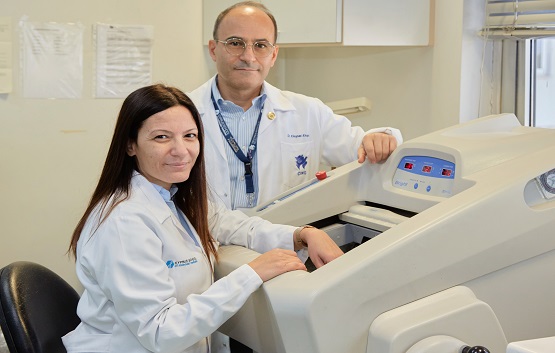Neuromuscular Disorders Center (NDC)
EMG Laboratory
The EMG laboratory provides services for the investigation of the peripheral nervous system including neuropathies, radiculopathies, plexopathies, myopathies and neuromuscular junction defects. Some of the services are Nerve Conduction Studies, Blink Reflex, Jaw Jerk Reflex, Masseter Inhibitory Reflex, Repetitive stimulation, Mixed nerve, Inching technique, Autonomic testing, H‐reflex, Electromyography, Quantitative EMG, Single fibre EMG.
List of Services:
- Nerve conduction studies (NCS, Mixed NCS, Inching)
- Late responses (H-reflex, F-waves)
- Repetitive nerve stimulation (RNS)
- Electromyography (EMG, Quantitative EMG, Single fiber EMG)
- Brainstem reflex studies (Blink, Jaw Jerk, Masseter Inhibitory Reflex (MIR))
- Autonomic testing (Sympathetic skin response (SSR))
Referrals:
Appointments are made only after reception of written, unexpired referral letters from:
- Non-GESY neurologist or neurosurgeon
- GeSY general (adult or pediatric) practitioner WITH a GeSY referral letter for NEUROLOGY
- GeSY neurosurgeon or neurologist WITH a GeSY referral letter for NEUROLOGY
- CING Neurologist WITH a GeSY referral letter for NEUROLOGY
It is preferable that referring physicians also complete the CING EMG Referral Letter in addition to their own referral in order to accurately document contraindications, test codes, patient consent, etc.
The completed referral letter/s can be submitted by hand or FAX (22392786).
Patients are advised to comply with the instructions on the Patient Preparation sheet (Greek, English) before coming to their appointment.
Examinations Performed:
The EMG Laboratory offers a wide range of examinations such Nerve Conduction Studies, Electromyography and Autonomic Nervous System Evaluation. Only the tests, which are appropriate to the patient’s condition, are performed.
Nerve Conduction Studies
Nerve Conduction Studies (NCS) evaluate the function of individual nerves. During NCS, a nerve is stimulated (electrical pulse) at one location while electrodes (wires taped to the skin) record from a different place along the same nerve. The NCS is performed to measure the timing (latency, conduction velocity), size (amplitude), and shape (morphology) of the nerve’s response to the stimulus across any given segment of its pathway. NCS can be performed on motor, sensory or on both motor and sensory nerves.
Electromyography
Electromyography (EMG) utilizes a disposable needle to view the spontaneous and volitional electrical activity of muscle, or motor unit potentials (MUPs). Specialized EMG techniques such as Quantitative EMG (QEMG) and Single Fiber EMG (SFEMG). QEMG techniques, record and analyse a representative sample of MUPs from a given muscle, whereas SFEMG assesses the neuromuscular junction by activating a motor nerve and recording its individually generated muscle fiber action potentials
Late Reponses
Late Reponses are performed to evaluate nerve conduction in more proximal portions of the nerve (near the spine). The EMG lab performs H-reflexes and F-waves of various nerves.
Repetitive Nerve Stimulation
This procedure evaluates the neuromuscular junction by recording muscle responses to a series of electrical stimuli both before and after exercise or following a train of high-frequency stimuli.
Brainstem Reflex Studies
These studies assess different brainstem pathways by recording muscle responses to a series of electrical or mechanical stimuli. The EMG Lab performs three types of reflex studies: Blink Reflex, Jaw Jerk Reflex and Masseter Inhibitory Reflex.
Autonomic Testing
The sympathetic, or galvanic, skin response (SSR) detects changes in skin resistance (i.e., sweat gland activation) in response to a sudden stimulus (e.g., cough, gasp, acoustic, electrical). As the SSR provides a measure of sympathetic cholinergic sudomotor fiber activity, abnormal SSR results may help to confirm a diagnosis of autonomic dysfunction.






0002.jpg)
